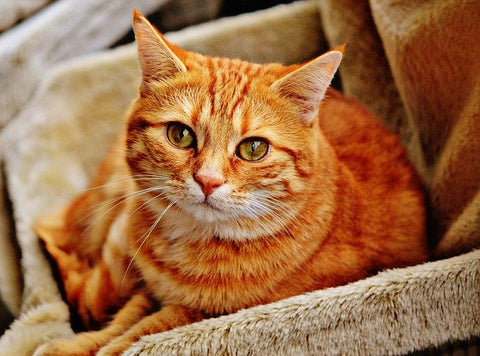Shopping Cart ( )
Your cart is currently empty.
Feeding cats wild-type food at home is feasible, but care must be given to ensure that it’s balanced and appropriate.
The main concern is quantity. Too little food and your cat may end up malnourished, too much and your cat may end up with a plethora of health issues because it’s overweight. So, how much BARF exactly should be given to your cat every day?
Before setting the amount of BARF you should feed your cat, you must consider the following factors as each cat is unique:
Kittens should be fed approximately 2% to 5% of their body weight daily. Most fast-growing kittens are fed 5% of their body weight every day.
Remember to weigh your kitten regularly to keep track of their progress and modify their feeding portions as needed.
You can start using adult feeding percentages when they're 8 to 12 months old.

Feeding 2% of body weight is a good rule of thumb. For example, a 5kg cat will need approximately 100g of food per day.
Depending on the factors stated above, you can adjust the amount. If you're not sure of your cat’s weight, you can always schedule an appointment with your veterinarian to find out.
Senior cats have decreased energy requirements and a predisposition to acquire fat and lose muscle mass. They’re less active and their metabolism has slowed down.
Hence, the general feeding guideline for senior cats is 1.5% of their current body weight per day.

Feeding pregnant cats is slightly different as it corresponds to their kitten's growth and energy needs. Here's a guideline that can help you:
The charts below show the suggested amounts of raw food to feed your adult cat based on 2% to 4% of their body weight. The per meal amount is divided based on two meals per day.
You can follow this feeding guideline if your cat is young or active.
| Weight (kg) | Daily Amount (g) | Per Meal (g) |
|---|---|---|
| 3 | 120 | 60 |
| 3.5 | 140 | 70 |
| 4 | 160 | 80 |
| 4.5 | 180 | 90 |
| 5 | 200 | 100 |
| 5.5 | 220 | 110 |
| 6 | 240 | 120 |
| 6.5 | 280 | 130 |
| 7 | 300 | 140 |
| 7.5 | 320 | 150 |
| 8 | 340 | 160 |
This guide is suitable if your cat has a regular activity level or if you wish to keep their present weight.
| Weight (kg) | Daily Amount (g) | Per Meal (g) |
|---|---|---|
| 3 | 90 | 45 |
| 3.5 | 105 | 52.5 |
| 4 | 120 | 60 |
| 4.5 | 135 | 67.5 |
| 5 | 150 | 75 |
| 5.5 | 165 | 82.5 |
| 6 | 180 | 90 |
| 6.5 | 195 | 97.5 |
| 7 | 210 | 105 |
| 7.5 | 225 | 112.5 |
| 8 | 240 | 120 |
Follow this chart if your cat is older or is overweight.
| Weight (kg) | Daily Amount (g) | Per Meal (g) |
|---|---|---|
| 3 | 60 | 30 |
| 3.5 | 70 | 35 |
| 4 | 80 | 40 |
| 4.5 | 90 | 45 |
| 5 | 100 | 50 |
| 5.5 | 110 | 55 |
| 6 | 120 | 60 |
| 6.5 | 130 | 65 |
| 7 | 140 | 70 |
| 7.5 | 150 | 75 |
| 8 | 160 | 80 |
The unique selling point of a BARF meal is that it consists not only of raw meats but includes other fresh foods, such as vegetables and fruits.
Typically, you can feed 5-10g of pureed raw veg for every 90-95g of meat. Although cats usually dislike veggies, by pureeing and smearing it on raw meat or blending it into mince, you’ll find that they will devour it without fuss.
Many cats enjoy sweeter veggies like carrots and pumpkins, but try to give a range of vegetables, including leafy greens.
Additionally, it is assumed that you should only feed your cat one type of raw meat. But did you know that providing only one meat source would not really benefit your pet nutritionally?
This is because each type of meat has its own amino acid profile. Hence, by providing variety, you're allowing your cat to consume a broader spectrum of nutrients.
So, do start with feeding your cat at least three different varieties of meat a week, such as chicken, fish, or beef.
Besides that, some cat parents are concerned about feeding their pets bones. But feeding your cat raw meaty bones is highly beneficial for their oral health.
It can help them reduce the growth of tartar, which is one of the leading causes of periodontal diseases in cats.
Do keep in mind that the bones should be served with plenty of meat on them and should come from a prey source that your pet would be expected to pursue in the wild. You can feed your cat raw meaty bones, such as chicken wings, once every 2-3 days.
As for organ meat, don’t forget to include tripe, which is abundant in certain vitamins. Make sure the heart is on the menu frequently as well. This is because taurine, which is abundant in heart tissue, is essential for cats' survival.
You can start off by providing fresh tripe, such as kidney, heart, lung, or liver, once a week or 1/6 of daily intake.
Follow these simple guidelines, and you have already taken the step in learning how much BARF you should feed your cat.
If you're wondering what raw meal that is nutritionally complete to provide your kitty, you can try out PetCubes' Raw Cat Food. Our meals are made with the best fresh human-grade ingredients that are sure to increase your feline's health.
Dr Francis is one of the top wildlife nutritionists in Asia. Originating from Montreal, Canada, he left at 21 to pursue his Masters and subsequently a PhD in wildlife nutrition at Oxford Brookes University. Instead of taking the path of common animal science to learn about farm animals, or through the veterinarian space and taking a certificate in nutrition, he took the road less travelled to dive deep into the world of animal ecology, metabolism and nutrition.
Dr Francis is one of the top wildlife nutritionists in Asia. Originating from Montreal, Canada, he left at 21 to pursue his Masters and subsequently a PhD in wildlife nutrition at Oxford Brookes University. Instead of taking the path of common animal science to learn about farm animals, or through the veterinarian space and taking a certificate in nutrition, he took the road less travelled to dive deep into the world of animal ecology, metabolism and nutrition.
You have no items in wishlist.
| Title |
|---|
| Price |
| Add to cart |
| Type |
| Vendor |
| Title |
|---|
| Price |
| Add to cart |
| Type |
| Vendor |

